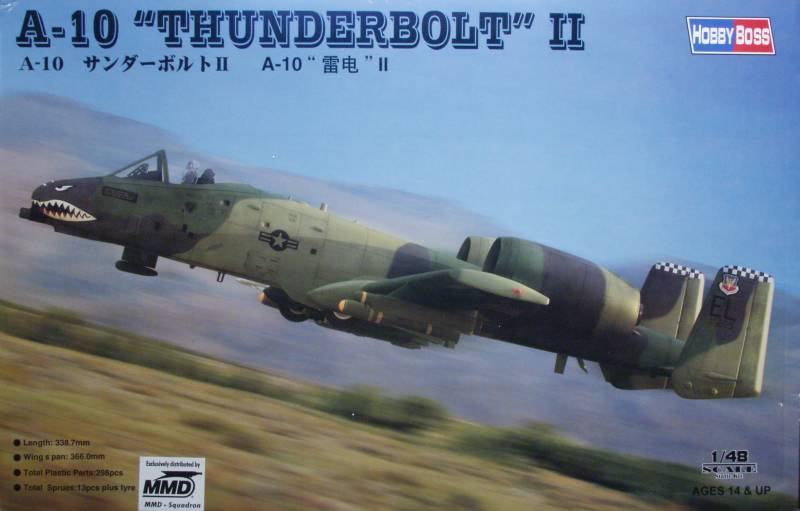
A-10

The Fairchild Republic A-10 Thunderbolt II is an American twin-engine, straight wing jet aircraft developed by Fairchild-Republic in the early 1970s. It is the only United States Air Force production aircraft designed solely for close air support, including attacking tanks, armored vehicles, and other ground targets with limited air defenses.
The A-10 was designed around the 30 mm GAU-8 Avenger rotary cannon that is its primary armament. The A-10's air frame was designed for durability, with measures such as 1,200 pounds (540 kg) of titanium armor to protect the cockpit and aircraft systems, enabling it to absorb a significant amount of damage and continue flying. The A-10A single-seat variant was the only version built, though one A-10A was converted to an A-10B twin-seat version. In 2005, a program was begun to upgrade remaining A-10A aircraft to the A-10C configuration.
The A-10's official name comes from the Republic P-47 Thunderbolt of World War II, a fighter that was particularly effective at close air support. The A-10 is more commonly known by its nicknames "Warthog" or "Hog". Its secondary mission is to provide airborne forward air control, directing other aircraft in attacks on ground targets. Aircraft used primarily in this role are designated OA-10. With a variety of upgrades and wing replacements, A-10's service life may be extended to 2028, though there are proposals to retire it sooner.
The A-10 has superior maneuverability at low speeds and altitude because of its large wing area, high wing aspect ratio, and large ailerons. The wing also allows short takeoffs and landings, permitting operations from primitive forward airfields near front lines. The aircraft can loiter for extended periods and operate under 1,000 ft (300 m) ceilings with 1.5 mi (2.4 km) visibility. It typically flies at a relatively low speed of 300 knots (350 mph; 560 km/h), which makes it a better platform for the ground-attack role than fast fighter-bombers, which often have difficulty targeting small, slow-moving targets.
The leading edge of the wing has a honeycomb structure panel construction, providing strength with minimal weight; similar panels cover the flap shrouds, elevators, rudders and sections of the fins. The skin panels are integral with the stringers and are fabricated using computer-controlled machining, reducing production time and cost. Combat experience has shown that this type of panel is more resistant to damage. The skin is not load-bearing, so damaged skin sections can be easily replaced in the field, with makeshift materials if necessary. The ailerons are at the far ends of the wings for greater rolling moment and have two distinguishing features: The ailerons are larger than is typical, almost 50 percent of the wingspan, providing improved control even at slow speeds; the aileron is also split, making it a deceleron.
The A-10 is designed to be refueled, rearmed, and serviced with minimal equipment. Also, most repairs can be done in the field. An unusual feature is that many of the aircraft's parts are interchangeable between the left and right sides, including the engines, main landing gear, and vertical stabilizers. The sturdy landing gear, low-pressure tires and large, straight wings allow operation from short rough strips even with a heavy aircraft ordnance load, allowing the aircraft to operate from damaged airbases, flying from taxiways or even straight roadway sections.
The front landing gear is offset to the aircraft's right to allow placement of the 30 mm cannon with its firing barrel along the center line of the aircraft. During ground taxi, the offset front landing gear causes the A-10 to have dissimilar turning radii. Turning to the right on the ground takes less distance than turning left. The wheels of the main landing gear partially protrude from their nacelles when retracted, making gear-up belly landings easier to control and less damaging. All landing gears are hinged toward the aircraft's rear; if hydraulic power is lost, a combination of gravity and wind resistance can open and lock the gear in place.
The Kit

This is one of those kits that is not going to get a full review by me as I feel it has been covered well by other sites. See the review links below.
After Market Goodies
Aries makes both a cockpit set and a gear bay set. Eduard makes a mask set and a color interior photoetch set.
Conclusions
Hobby Boss kits are all over the map when it comes to accuracy, ease of build and overall quality. This one seems to be one of their better ones and until I have had the opportunity to actually build it I will give it a tentative recommendation.
Links to kit build or reviews
A build review can be found here and an inbox review here and one here, though in German, has good photos of the sprues and other parts, as does this one here, in French.
References
A-10 Warthog by Lou Drendel
Wikipedia